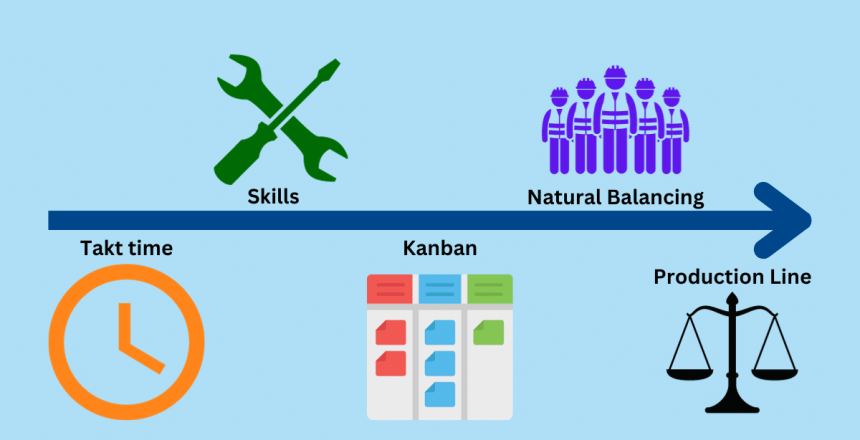In the world of manufacturing, efficiency is the name of the game. Whether you’re producing cars, electronics, or even food, achieving a smooth and efficient production process is crucial for success. One key concept that can significantly enhance efficiency is “line balancing.”
In this article, we’ll delve into the art and science of line balancing, why it’s essential, and the tools and techniques you can use to optimize your production line.
What is Line Balancing?
Line balancing is the process of evenly distributing the workload across various workstations or stations in a production line to minimize bottlenecks and maximize efficiency.
Essentially, it ensures that each station within the production line operates at its maximum capacity, preventing any idle time or overloading of workers and machinery.
Why Is Line Balancing Important?
Line balancing is of paramount importance in manufacturing for several reasons:
1. Improved Efficiency
Balancing the production line reduces idle time and ensures that every worker and machine is consistently engaged.
This translates to a smoother workflow, shorter lead times, and increased production output.
2. Cost Reduction
Balanced production lines drive cost reduction through:
1. Minimized Overtime Costs: Evenly distributed workloads in balanced production lines reduce the need for expensive overtime labor, saving on labor costs.
2. Reduced Inventory Holding Costs: Aligning production with demand reduces excess inventory, cutting capital ties, and lowering storage expenses.
3. Optimized Resource Utilization: Balanced lines ensure every resource operates at maximum capacity, eliminating inefficiencies and unnecessary costs.
4. Enhanced Productivity: With fewer interruptions and waiting times, workers become more productive, increasing output without additional labor or machinery expenses.
3. Enhanced Quality
When workstations are balanced, workers have the time and focus to perform their tasks meticulously, leading to higher product quality and reduced defects.
4. Adaptability
Line balancing makes it easier to adapt to changes in demand.
When your production line is balanced, it’s simpler to adjust the number of workers or machines at each station to meet fluctuating production needs.
Key Concepts in Line Balancing
To effectively balance your production line, you need to understand several key concepts and tools. Let’s explore some of these essential components:
1. Takt Time
Takt time is the heartbeat of your production line. It’s the available production time divided by the customer demand. This metric sets the pace at which your production line should operate to meet customer requirements.
For example, if you have 480 minutes available in a shift and a customer demand of 240 units, your takt time would be 2 minutes per unit.
2. Work Element Analysis
Work element analysis involves breaking down each task or operation at a workstation into its smallest components. This helps identify opportunities for optimization, such as reducing cycle times or simplifying tasks.
3. Skill Matrix
A skill matrix is a tool that categorizes workers based on their skills and abilities. It helps you allocate tasks to workers with the right skill set, ensuring that each worker is assigned to a task they are competent in, which can improve efficiency and reduce errors.
Example :
4. Workstation Layout
The physical layout of workstations plays a significant role in line balancing and a major role in production efficiency. y
Organize your workstations in a way that minimizes material handling, reduces worker movement, and optimizes the flow of materials and products.
5. Heijunka (Production Smoothing)
Heijunka is a foundational concept in lean manufacturing that focuses on leveling production to minimize fluctuations in workload. The essence of Heijunka lies in the ability to match production output with customer demand, thereby enhancing the overall efficiency of your production line.
By smoothing out production, Heijunka achieves several key benefits:
1. Reduced Waste: Fluctuations in production can lead to overproduction, excess inventory, and unnecessary costs. Heijunka mitigates these issues by ensuring that production rates align closely with customer demand, reducing waste and associated expenses.
2. Improved Line Balancing: A stable, leveled production environment naturally promotes better line balancing. With consistent workloads, it becomes easier to allocate resources and tasks efficiently, reducing bottlenecks and idle time.
3. Enhanced Flexibility: Heijunka enhances a manufacturer’s ability to respond to changing customer demands. A leveled production system is more adaptable, allowing for quick adjustments to meet fluctuating production needs without disruptions.
4. Smoother Workflow: A consistent production pace leads to smoother workflows, decreased stress on employees, and a more predictable and manageable production environment.
In essence, Heijunka is about achieving harmony between production and customer demand, leading to greater efficiency and reduced waste, all while maintaining a balanced and flexible production line.
6. Kanban
Kanban is a Japanese term that translates to “visual card” or “signal.” It is a widely adopted lean manufacturing technique that helps optimize production flow and inventory management.
Kanban cards or signals are used to signal the need for more parts or materials at a specific workstation in the production line. Kanban systems ensure that production is demand-driven, preventing overproduction and minimizing waste (see next section).
Implementing Kanban in your line balancing strategy involves:
- Visual Signals: Using physical cards, boards, or electronic systems to signal when a workstation needs more materials or when a product is ready to move to the next stage.
- Pull System: Adopting a pull system, where production is driven by customer demand rather than pushing products through the line regardless of demand.
- Inventory Control: Keeping a close eye on inventory levels to avoid excessive stockpiles and reduce carrying costs.
7. Natural Line Balancing
Natural line balancing is a concept that leverages the skills and capabilities of your workforce to balance the production flow organically. It involves empowering employees to help each other, either upstream or downstream, to maintain a smooth workflow. The skill matrix mentioned earlier plays a vital role in enabling natural line balancing.
Here’s how it works:
- Skill Matrix Integration: Utilize the skill matrix to identify the range of tasks each worker is capable of performing. This information helps you make informed decisions about task assignments.
- Cross-Training: Encourage cross-training among employees, allowing them to develop skills beyond their primary responsibilities. This enhances flexibility and enables employees to fill in gaps when needed.
- Team Collaboration: Foster a culture of collaboration and teamwork on the production floor. When a bottleneck or slowdown occurs, employees with relevant skills can step in to assist without the need for complex reassignment processes.
- Kanban Support: Combine natural line balancing with Kanban systems. When a workstation experiences a delay, nearby workers can help clear the bottleneck and ensure the flow of production is maintained.
Natural line balancing harnesses the collective skills and expertise of your workforce to optimize production flow, making your line more adaptable and efficient.
By incorporating Kanban and Natural Line Balancing into your line balancing strategy, you can further enhance the efficiency and agility of your production line, ensuring that it operates at its full potential while minimizing waste and delays.
What Are the 8 Production Wastes in Lean Manufacturing?
In the world of lean manufacturing, waste is the enemy of efficiency. Identifying and eliminating waste is a cornerstone of lean principles.
There are eight common types of waste, often referred to as the “eight wastes of lean,” that can plague production processes.
Let’s explore each of these wastes and discuss strategies for avoiding them.
1. Overproduction
Overproduction occurs when you produce more than what is currently needed or expected by the customer. This leads to excess inventory, storage costs, and potential obsolescence. To avoid overproduction, align your production with customer demand, utilizing tools like takt time and demand-driven production systems.
2. Inventory
Excess inventory ties up capital and warehouse space, leading to higher carrying costs. Implement just-in-time (JIT) inventory management to reduce inventory levels, only ordering and producing what is necessary when it’s needed.
3. Waiting
Waiting for waste occurs when workers or machines are idle due to bottlenecks or delays in the production process.
Optimize workflow and eliminate downtime by balancing production lines, adjusting workstations, and using Kanban systems to signal when the next task can begin.
4. Transportation
Unnecessary movement of materials or products can lead to increased handling costs, damage, and delays. Minimize transportation waste by organizing workstations logically and reducing the distance between processes or stations.
5. Overprocessing
Overprocessing involves using more resources or time than necessary to create a product. Streamline processes and eliminate redundant or non-value-added steps to reduce overprocessing waste.
6. Defects
Defects result in rework, scrap, and decreased customer satisfaction. Implement quality control measures, such as error-proofing (poka-yoke), to prevent defects from occurring in the first place.
The foundation of a successful production process is ensuring that products are created right the first time, in the right quantity, and at the right time. This unwavering commitment to quality is paramount to meeting customer expectations and maintaining a competitive edge.
7. Motion
Motion waste refers to excessive or unnecessary movement by workers.
Optimize workstation layouts, provide ergonomic equipment, and minimize the distance workers must travel to perform their tasks.
8. Underutilized Employee Skills
Failing to tap into the full range of skills and knowledge possessed by your workforce is a waste of human resources. Encourage cross-training and empower employees to contribute their expertise when addressing production challenges.
Understanding and actively addressing these eight wastes creates a more efficient and cost-effective production process that maximizes value, minimizes waste, and delivers higher-quality products to your customers.
Lean manufacturing principles provide a roadmap for achieving these improvements, ensuring that your operations are streamlined and continually optimized.
Practical Example: Balancing an Assembly Line for Smartphones
Imagine you’re the manager of a smartphone manufacturing facility, and your goal is to optimize the production process.
Here’s a step-by-step example of how you can balance the assembly line for smartphones, incorporating Kanban and Natural Line Balancing:
Step 1: Identify Takt Time
Scenario: Your production line needs to manufacture 100 smartphones in an 8-hour shift.
Calculation: Takt Time = Available Production Time / Customer Demand
Result: Takt Time = 480 minutes (8 hours) / 100 units = 4.8 minutes per smartphone.
So, to meet customer demand, you must produce one smartphone every 4.8 minutes.
Step 2: Work Element Analysis
Task Breakdown: Break down the smartphone assembly process into its constituent tasks, such as attaching the screen, installing the battery, and configuring software. Measure the time required for each task and identify any bottlenecks or tasks taking longer than the 4.8-minute takt time.
Example: Installing the screen takes 5.2 minutes, while installing the battery only takes 3.5 minutes.
Step 3: Skill Matrix
Assessment: Assess your workers’ skills and create a skill matrix to match workers with tasks. Ensure that employees are cross-trained in multiple tasks to maintain flexibility.
Example: Worker A is skilled at installing screens, and Worker B excels at software configuration. Cross-train them to handle each other’s tasks as needed.
Step 4: Workstation Layout
Organization: Arrange workstations logically to minimize unnecessary worker movement and material handling. Each workstation should be well-equipped with tools and materials to eliminate delays.
Example: Place screens, batteries, and tools within easy reach of the assembly stations to reduce the time workers spend searching for supplies.
Step 5: Heijunka
Production Leveling: Adjust the number of workers or machines at each workstation to match the takt time of 4.8 minutes per smartphone. Monitor workstation performance and reallocate tasks or resources if one workstation consistently lags behind.
Example: If the screen installation station takes longer than 4.8 minutes, add an additional worker or machine to ensure production matches the required pace.
Step 6: Kanban Implementation
Visual Signals: Introduce a Kanban system to signal when workstations need more materials or when a product is ready to move to the next stage. This ensures that production is demand-driven, preventing overproduction and minimizing waste.
Example: Use color-coded cards to signal when a workstation needs more batteries or when a smartphone is ready for quality control.
Step 7: Natural Line Balancing
Collaborative Workflow: Foster a culture of collaboration among workers. Encourage them to help each other, whether it’s upstream or downstream, to maintain a smooth workflow. Workers can naturally balance the production flow by leveraging their skills and knowledge.
Example: If a worker at the battery installation station finishes early, they can assist their colleague at the screen installation station, preventing bottlenecks.
Applying these concepts and tools makes your assembly line a well-balanced system that operates efficiently, meets customer demand, minimizes waste, and empowers workers to adapt to changing needs.
It’s a finely tuned machine where Kanban ensures just-in-time production, and Natural Line Balancing leverages the skills and collaboration of your workforce for maximum productivity.
Conclusion
In the world of manufacturing, efficiency is the linchpin of success. Balancing your production line is the key to unlocking that efficiency.
By optimizing processes, minimizing waste, and leveraging tools like takt time, work element analysis, skill matrices, workstation layout, Heijunka, Kanban, and Natural Line Balancing, you can transform your production line into a well-oiled machine.
The result? Enhanced quality, reduced costs, improved adaptability, and a competitive edge in today’s fast-paced market. So, embrace the art and science of line balancing, and watch your manufacturing efficiency soar to new heights.









